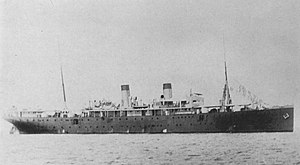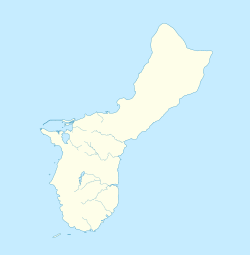SMS Cormoran (1909)

SMS Cormoran
|
|
| History | |
|---|---|
|
|
|
| Name: | SMS Cormoran aka SMS Cormoran II |
| Namesake: | SMS Cormoran I |
| Builder: | Schichau Yard at Elbing |
| Launched: | 1909 as SS Ryazan |
| Acquired: | captured by SMS Emden |
| Commissioned: | 10 August 1914 as SMS Cormoran II |
| Fate: | scuttled at Apra Harbor, Guam on 7 April 1917 |
| General characteristics | |
| Displacement: | 3,500 t (3,400 long tons) |
| Speed: | 17 kn (31 km/h; 20 mph) |
| Armament: | 8 × 105 mm (4.1 in) quick-firing guns |
|
|
|
| Location | Apra Harbor |
| Nearest city | Piti, Guam |
| Coordinates | 13°27′33″N 144°39′15″E / 13.45917°N 144.65417°ECoordinates: 13°27′33″N 144°39′15″E / 13.45917°N 144.65417°E |
| Area | 0.1 acres (0.040 ha) |
| Built | 1909 |
| NRHP Reference # | 75002156 |
| Added to NRHP | April 4, 1975 |
SMS Cormoran or SMS Cormoran II was built at the Schichau shipyard in Elbing, Imperial Germany in 1909 for the Russian merchant fleet and was named SS Ryazan (Rjasan or Rjäsan, from the Russian town of Ryazan). She was used by imperial Russia as a combination passenger, cargo and mail carrier on North Pacific routes.
The SS Ryazan was captured southeast of the Korean peninsula by the light cruiser SMS Emden on 4 August 1914 as the first prize of World War I from the Russian empire. She was taken to Tsingtao in the German colony Kiautschou, where she was converted to an armed merchant raider. The new Cormoran replaced the original SMS Cormoran, a small shallow draft cruiser that had a long Imperial Navy career in the Pacific, having taken part in the events that brought Kiautschou into the German colonial empire in 1897–98. The old Cormoran was laid up at Tsingtao with serious maintenance issues and unable to go to sea, and her armaments were transferred to the captured merchant ship.
On 10 August 1914, the new Cormoran (or Cormoran II) left Tsingtao harbor and sailed through the South Pacific region, pursued by Japanese warships. On 14 December, she pulled into Apra Harbor in the U.S. Territory of Guam, having only 50 t (55 short tons) of coal remaining in her bunkers.
Due to strained diplomatic relations between the United States and Germany, plus the limited amount of coal stored at Guam, Governor William John Maxwell refused to supply Cormoran with more than a token amount of coal. He ordered the ship to leave within 24 hours or submit to detention. This created a standoff between the German crew and the Americans that lasted nearly two years, until Governor Maxwell was involuntarily placed on the sick list and replaced by his subordinate, William P. Cronan, who decided the German crew should be treated as guests of the United States. The Cormoran was not allowed to leave the harbor, but the crew were treated as friends, achieving a minor celebrity status on the island.
...
Wikipedia

